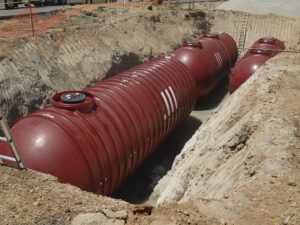
Underground storage tanks have been federally regulated since the 1980’s because the materials that they hold can be problematic if accidentally released.
When we talk about the many uses of ground penetrating radar (GPR), we often focus on its ability to find things below the surface of the ground, like voids that could cause a cave-in, or embedded items in concrete, like rebar or utility conduits. Another thing that might be underground that you don’t even know is there is a Underground storage tank or underground storage tank. Read on for a primer on underground storage tanks so that you’re prepared in the event you find one.
What Are USTs?
UST stands for Underground Storage Tanks and they are exactly as the name says: tanks used for storage that are buried under the ground. Often these are single tanks, but occasionally they can be an interconnected series of containers. An underground storage tank usually consists of three types of parts: the tank or tanks, an underground pipe network, and any ancillary equipment that goes with the system. Underground storage tanks are typically used for storage of different types of liquids, often including sewage, heating oil, and others.
What Are Underground Storage Tanks Made Of?
Often these tanks are made of steel or aluminum. They might be composite over-wrapped on the metal tanks, or metal lined composite tanks. Occasionally, these tanks might even be composite tanks with carbon fiber and polymer liners. The type of material being stored will influence the type of tank material.
Are Underground Storage Tanks Regulated?
Underground storage tanks have been federally regulated since the 1980’s because the materials that they hold can be problematic if accidentally released. For instance, heating oil and petroleum products that could potentially leak out of such a tank would be a huge environmental issue. There are sometimes state level restrictions as well, which are usually stricter than the federal guidelines if they are in place. There should be a local regulatory agency in your area that can help you to understand the various regulations and what you need to do to make sure your tanks stay in compliance.
Can You Close Them?
There are rules associated with how to close underground storage tanks, either closing them permanently or temporarily. These rules usually apply to any tanks that were in use after December 22, 1998. These rules (outlined in 40 CFR 280.70) include notifying agencies of the closure and correcting any contamination. They don’t regulate if the tank can be left in the ground or have to be removed. Either is an option, as long as the regulations are followed.
Concrete Visions Will Get The Job Done Right
Concrete Visions has been working with clients for over 25 years. Our G&M Services installers are certified with the industry’s major firestop product manufacturers. As part of our firestop service, we can assess abnormal field conditions and, with the manufacturer’s technical support assistance, provide engineering judgments in a timely fashion to comply with contract specifications. Our Field Mechanics undergo ongoing training, including mandatory monthly safety meetings, weekly Toolbox Talks where safety and equipment information is shred, and trainings on safe work standards and safety best practices.
